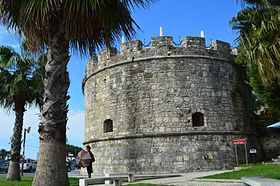Durrës Castle
| Durrës Castle Kalaja e Durrësit | |
|---|---|
| Durrës, Albania | |
 Venetian Tower of Durrës | |
| Coordinates | 41°18′35″N 19°26′49″E / 41.3097°N 19.4470°E |
| Site information | |
| Owner | |
| Controlled by | The Big Four (World War I) |
| Site history | |
| Built | 1st century BC (final form in 5th century) |
| Built by | Final form created by Emperor of the Byzantine Empire Anastasius I Dicorus |
| Battles/wars | Battle of Dyrrhachium (1018), Battle of Dyrrhachium (1081), Battle of Durrës (1939) |
| Events | Miss Shqipëria 2009 |
Durrës Castle (Albanian: Kalaja e Durrësit) is the fortified old city of Durrës, Albania. It is enclosed by city walls built in the late 5th century, and repaired and reinforced in the Middle Ages and early modern periods.
History[edit]
The castle was built by the Byzantine Emperor Anastasius I (r. 491–518), a native of Durrës (ancient Dyrrhachium), who was born into an Illyro-Roman family.[1][2] At the time, Anastasius made the city one of the most fortified cities on the Adriatic.[3][4] The ancient walls were devastated in an earthquake in 1273, and had to be extensively repaired.
 After the Venetians seized Durrës in 1392 from Gjergj Thopia, they set to improve the castles already impressive fortifications, reinforcing it with several guard towers. The walls are quoted as early as the 11th century by Byzantine princess and historian Anna Komnene in her Alexiad as having been so thick, that "four horsemen could ride abreast on top of them".[5][6] The castle remained under Venetian sovereignty until 1501, when Durrës fell to the Ottoman Empire, which would end up holding the city until 1912. During Ottoman Rule, the walls were again reinforced. Currently the medieval walls stand at nearly 15 feet (4.6 meters) in height and the three entrances of some of the fortification towers are preserved in nearly one-third of the original length of the city walls.  On 7 April 1939, Albanian patriots fought the Italian invasion of Albania. In Durrës, a force of only 360 Albanians, mostly gendarmes and townspeople, led by Abaz Kupi, the commander of the gendarmerie in Durrës, and Mujo Ulqinaku, a marine official, tried to halt the Italian advance. Armed only with small arms and three machine guns, they succeeded in keeping the Italians at bay for several hours until a large number of light tanks disembarked from the latter's naval vessels. After that, resistance diminished and within five hours the Italian forces had captured the entire city.[7]
Modern[edit]In February 2022 it was announced that The Durrës Castle would begin Restoration on the Main Durrës Tower by the EU4Culture Group In Albania. This Restoration project is presumed to take 6 Months to Complete and the cost of investment for the project is 675,000 Euros. This Project will Conserve and Upgrade the Infrastructure of the Tower and will add a new digital and classic interpretation of the tower and many other things that will go beyond just a regular Infrastructure Repair. This Restoration will turn the Durrës Tower into the first heritage interpretation center in Albania.[8][9] Gallery[edit]
See also[edit]
References[edit]
|





